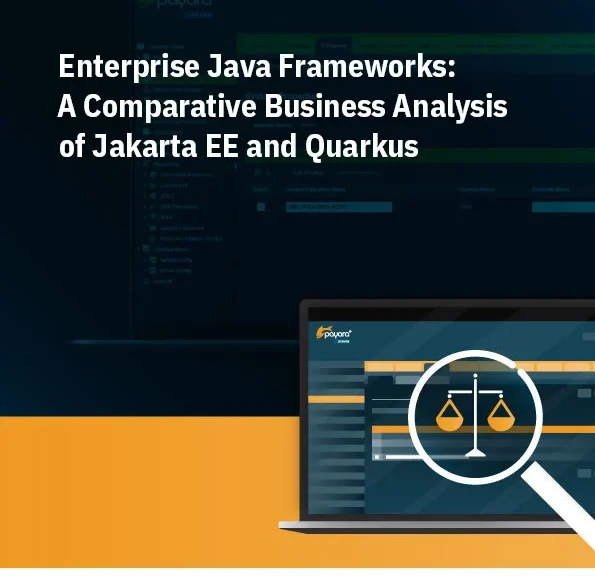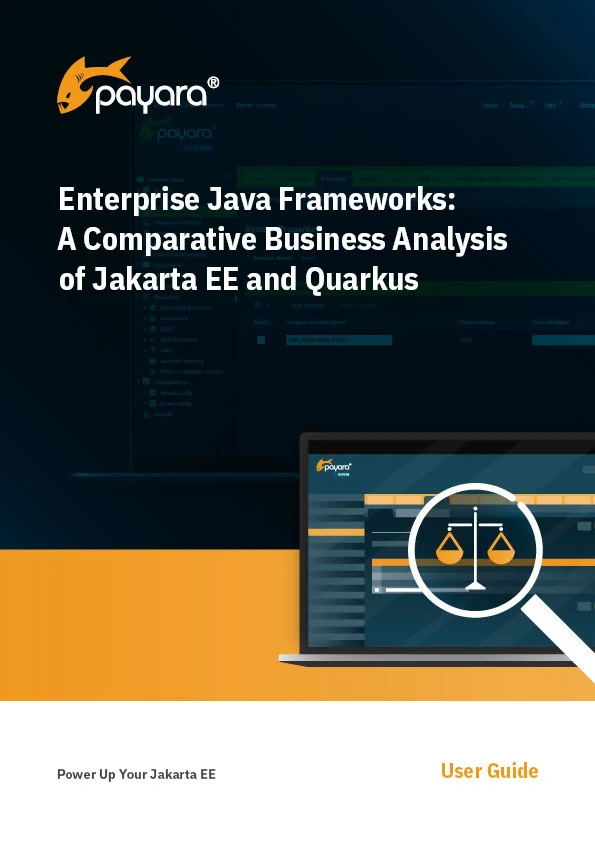 3 minutes
3 minutes
End-of-Life Technology: How to Drive Innovation Without Compromising Stability
When legacy systems approach end-of-life (EOL), enterprise IT teams typically face the choice of moving forward at all costs […]

Enterprise Java has powered backend systems and key applications for three decades, evolving steadily alongside application architecture trends, from on-premise monoliths and service-oriented architectures to today’s cloud-first containerized microservices. Currently, developers can typically choose from three key enterprise Java frameworks: Jakarta EE, Quarkus and Spring / Spring Boot.
In this post, we take a practical look at two major enterprise Java frameworks: Jakarta EE, the continuation of the long-established Java EE/J2EE standard and Quarkus, a newer framework that is growing in popularity.
Note: For comparisons between Jakarta EE and Spring Boot, check the ‘Jakarta EE vs. Spring Boot: Choosing the Right Framework for Your Project’ blog post and the ‘Mastering Java Frameworks: Power Up Your Jakarta EE Skills As A Spring Boot Developer’ blog post.
Enterprise Java frameworks have a long history rooted in the needs of large organizations building server-side mission-critical applications at scale. The story begins shortly after the launch of Java, in the late 1990s, with J2EE (Java 2 Platform, Enterprise Edition). This technology was the answer to the growing demand for a standardized platform to build web, transactional and distributed applications in Java. Since then, J2EE became Java EE and a number of alternatives were developed, each with its own features, core capabilities and specific use cases.
In particular, the enterprise Java landscape expanded considerably in the late 2010s. In 2017, Oracle donated Java EE to the Eclipse Foundation, where it was rebranded as Jakarta EE. Meanwhile, deployment models shifted towards containers and microservices, with solutions like Quarkus designed to address these modern, cloud-native trends in software development.
Since then, all major enterprise Java have evolved to support new technologies and paradigms, making the choice of which solution to use perhaps more challenging for developers.
Both Jakarta EE and Quarkus enable developers to build robust enterprise Java applications, but they differ in design philosophy, runtime behavior and development experience. Jakarta EE focuses on standardization, compatibility and long-term stability across vendors, while Quarkus emphasizes fast startup, low memory usage and a streamlined developer workflow optimized for Kubernetes (K8s) and GraalVM.
Understanding their technical foundations and trade-offs is essential for developers choosing a framework for new projects or modernizing existing Java applications.
| Capability | Jakarta EE | Quarkus |
| Standards Compliance | Full implementation of Jakarta EE specifications | Implements subset of Jakarta EE and MicroProfile APIs |
| Deployment Model | Traditional application server deployment runtimes | Container-optimized deployment |
| Resource Requirements | Traditionally high memory footprint but newer runtimes (e.g. Payara Micro) use significantly less memory | Optimized memory usage, especially in native mode |
| Startup Time | Startup times are typically longer, but newer runtimes (e.g. Payara Micro) are much faster. | Faster startup, particularly in native mode |
| Development Experience | Mature tooling ecosystem | Developer-focused tools with fast feedback |
| Ecosystem Maturity | Extensive, mature ecosystem | Growing ecosystem with modern tooling |
| Vendor Lock-in Risk | Lower risk due to multiple vendor implementations (WildFly, Open Liberty, Payara, TomEE, etc.) | Higher risk with primary stewardship from Red Hat, though open-source foundation mitigates some risk |
The right choice depends on your goals: are you optimizing for compliance and stability, or cloud performance and developer velocity? Even more, you don’t need to choose one framework for all applications. In fact, in many enterprises, there’s no one-size-fits-all solution. A hybrid strategy that uses Jakarta EE where stability as well as compatibility matter and Quarkus where agility and performance are key can deliver optimal value.
Still unsure? Download our latest guide ‘Enterprise Java Frameworks: A Comparative Business Analysis of Jakarta EE and Quarkus’ for a deep dive into the two solutions and a hands-on, intuitive decision matrix to help you evaluate what’s best for your team based on:

Compare Jakarta EE vs Quarkus to choose the right Java framework for your enterprise.
This free guide provides an executive-level analysis of tradeoffs, deployment models, performance differences, and long-term flexibility — empowering your team to make informed framework decisions.
 3 minutes
3 minutes
When legacy systems approach end-of-life (EOL), enterprise IT teams typically face the choice of moving forward at all costs […]
 5 minutes
5 minutes
November has been one of the busiest months of the year for the Java and Jakarta EE ecosystem. With […]
 3 minutes
3 minutes
Working with enterprise Java databases can sometimes feel like swimming upstream. Jakarta EE 11’s Jakarta Data helps developers glide […]